
Parthenon Frieze
Encyclopedia
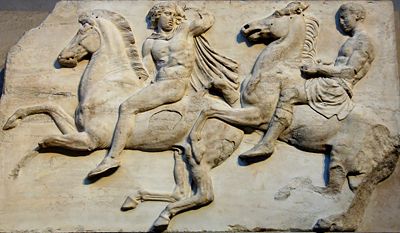
Penteli
Pentéli or Pendeli, , and Vrilissos or Vrilittos , Mendeli in medieval times) is a tall mountain and mountain range situated northeast of Athens and southwest of Marathon. Its elevation is 1,109 m...
c marble sculpture created to adorn the upper part of the Parthenon
Parthenon
The Parthenon is a temple on the Athenian Acropolis, Greece, dedicated to the Greek goddess Athena, whom the people of Athens considered their virgin patron. Its construction began in 447 BC when the Athenian Empire was at the height of its power. It was completed in 438 BC, although...
’s naos
Cella
A cella or naos , is the inner chamber of a temple in classical architecture, or a shop facing the street in domestic Roman architecture...
. It was sculpted between ca. 443 and 438 BC, most likely under the direction of Pheidias. Of the 524 feet (159.7 m) of the original frieze, 420 feet (128 m) survives—some 80 percent. The rest is known only from the drawings made by Flemish artist Jacques Carrey
Jacques Carrey
Jacques Carrey . French painter and draughtsman. An otherwise little noted and unremarkable artist he is now remembered almost exclusively for the series of drawings he made of the Parthenon, Athens, in 1674. Carrey was part of the embassy of Charles Marie François Olier, marquis de Nointel to...
in 1674, thirteen years before the Venetian bombardment that ruined the temple.
At present, the majority of the frieze is at the British Museum
British Museum
The British Museum is a museum of human history and culture in London. Its collections, which number more than seven million objects, are amongst the largest and most comprehensive in the world and originate from all continents, illustrating and documenting the story of human culture from its...
in London
London
London is the capital city of :England and the :United Kingdom, the largest metropolitan area in the United Kingdom, and the largest urban zone in the European Union by most measures. Located on the River Thames, London has been a major settlement for two millennia, its history going back to its...
(forming the major part of the Elgin Marbles
Elgin Marbles
The Parthenon Marbles, forming a part of the collection known as the Elgin Marbles , are a collection of classical Greek marble sculptures , inscriptions and architectural members that originally were part of the Parthenon and other buildings on the Acropolis of Athens...
); the largest proportion of the rest is in Athens
Acropolis Museum
The Old Acropolis Museum was an archaeological museum located in Athens, Greece on the archeological site of Acropolis. It is built in a niche at the eastern edge of the rock and most of it lies beneath the level of the hilltop, making it largely invisible. It was considered one of the major...
, and the remainder of fragments shared between six other institutions. Casts of the frieze may be found in the Beazley archive at the Ashmolean Museum
Ashmolean Museum
The Ashmolean Museum on Beaumont Street, Oxford, England, is the world's first university museum...
at Oxford, in the Skulpturhalle
Skulpturhalle Basel
The Skulpturhalle Basel is a museum in Basel, Switzerland, featuring cast replicas of antique sculpture. With around 2,000 casts it is the largest collection of its kind in the country, having tripled in size between 1985 and 2010. Since 1961 the collection has been managed by the Antikenmuseum...
at Basel
Basel
Basel or Basle In the national languages of Switzerland the city is also known as Bâle , Basilea and Basilea is Switzerland's third most populous city with about 166,000 inhabitants. Located where the Swiss, French and German borders meet, Basel also has suburbs in France and Germany...
and elsewhere.
Construction
PlutarchPlutarch
Plutarch then named, on his becoming a Roman citizen, Lucius Mestrius Plutarchus , c. 46 – 120 AD, was a Greek historian, biographer, essayist, and Middle Platonist known primarily for his Parallel Lives and Moralia...
’s Life of Pericles
Pericles
Pericles was a prominent and influential statesman, orator, and general of Athens during the city's Golden Age—specifically, the time between the Persian and Peloponnesian wars...
, 13.4–9, informs us “the man who directed all the projects and was overseer [episkopos] for him [Pericles] was Phidias... Almost everything was under his supervision, and, as we have said, he was in charge, owing to his friendship with Perikles, of all the other artists”. The description was not architekton, the term usually given to the creative influence behind a building project, rather episkopos. But it is from this claim, the circumstantial evidence
Circumstantial evidence
Circumstantial evidence is evidence in which an inference is required to connect it to a conclusion of fact, like a fingerprint at the scene of a crime...
of Phidias’s known work on the Athena Parthenos
Athena Parthenos
Athena Parthenos was the title of a massive chryselephantine sculpture of the Greek goddess Athena made by Phidias and housed in the Parthenon in Athens. Its epithet was an essential character of the goddess herself...
and his central role in the Periclean building programme that he is attributed authorship of the frieze. The frieze consists of 378 figures and 245 animals. It was 160 meters in length (524 ft) when complete, as well as 1 meter in height, and it projects 5.6 cm forward at its maximum depth. It is composed of 114 blocks of an average 1.22 meters in length, depicting two parallel files in procession. It was a particular novelty of the Parthenon that the cella
Cella
A cella or naos , is the inner chamber of a temple in classical architecture, or a shop facing the street in domestic Roman architecture...
carries an Ionic
Ionic order
The Ionic order forms one of the three orders or organizational systems of classical architecture, the other two canonic orders being the Doric and the Corinthian...
frieze
Frieze
thumb|267px|Frieze of the [[Tower of the Winds]], AthensIn architecture the frieze is the wide central section part of an entablature and may be plain in the Ionic or Doric order, or decorated with bas-reliefs. Even when neither columns nor pilasters are expressed, on an astylar wall it lies upon...
over the hexastyle pronaos rather than Doric
Doric order
The Doric order was one of the three orders or organizational systems of ancient Greek or classical architecture; the other two canonical orders were the Ionic and the Corinthian.-History:...
metopes
Metope (architecture)
In classical architecture, a metope is a rectangular architectural element that fills the space between two triglyphs in a Doric frieze, which is a decorative band of alternating triglyphs and metopes above the architrave of a building of the Doric order...
as would have been expected of a Doric temple. Judging by the existence of regulae and guttae below the frieze on the east wall this was an innovation introduced late in the building process and replaced the ten metopes and triglyph
Triglyph
Triglyph is an architectural term for the vertically channeled tablets of the Doric frieze, so called because of the angular channels in them, two perfect and one divided, the two chamfered angles or hemiglyphs being reckoned as one. The square recessed spaces between the triglyphs on a Doric...
s that might otherwise have been placed there.
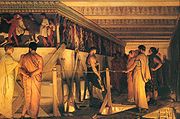
Acropolis of Athens
The Acropolis of Athens or Citadel of Athens is the best known acropolis in the world. Although there are many other acropoleis in Greece, the significance of the Acropolis of Athens is such that it is commonly known as The Acropolis without qualification...
. A persistent question has been whether it was carved in situ. Just below the moulding and above the tenia there is a channel 17 mm high that would have served to give access to the sculptor's chisel when finishing the heads or feet on the relief; this scamillus or guide strip is the best evidence there is that the blocks were carved on the wall. Additionally, on practical grounds it is easier to move a sculptor than a sculpture, and to crowbar
Crowbar (tool)
A crowbar, a wrecking bar, pry bar, or prybar, or sometimes a prise bar or prisebar, and more informally a jimmy, jimmy bar, jemmy or gooseneck is a tool consisting of a metal bar with a single curved end and flattened points, often with a small fissure on one or both ends for removing nails...
them into place could have potentially chipped the edges. No information is recoverable on the workshop, but estimates range from three to 80 sculptors on the basis of style, however Jenifer Neils suggests nine on the grounds that this would be the least number necessary to produce the work in the time given. It was finished with metal detailing and painted. No colour, however, survives, but the background was perhaps blue judging by comparison with grave stelae and the paint remnants on the frieze of the Hephaisteion
Temple of Hephaestus
The Temple of Hephaestus, also known as the Hephaisteion or earlier as the Theseion, is the best-preserved ancient Greek temple; it remains standing largely as built. It is a Doric peripteral temple, and is located at the north-west side of the Agora of Athens, on top of the Agoraios Kolonos hill....
. Possibly figures held objects that were also rendered in paint such as Poseidon
Poseidon
Poseidon was the god of the sea, and, as "Earth-Shaker," of the earthquakes in Greek mythology. The name of the sea-god Nethuns in Etruscan was adopted in Latin for Neptune in Roman mythology: both were sea gods analogous to Poseidon...
’s trident and the laurel in Apollo
Apollo
Apollo is one of the most important and complex of the Olympian deities in Greek and Roman mythology...
’s hand. The many drill holes found in Apollo’s and Hera
Hera
Hera was the wife and one of three sisters of Zeus in the Olympian pantheon of Greek mythology and religion. Her chief function was as the goddess of women and marriage. Her counterpart in the religion of ancient Rome was Juno. The cow and the peacock were sacred to her...
’s heads indicate that a gilded bronze wreath would probably have crowned the gods.
The system of numbering the frieze blocks dates back to Adolf Michaelis
Adolf Michaelis
Adolf Michaelis was a German classical scholar, a professor of art history at the University of Strasbourg from 1872, who helped establish the connoisseurship of Ancient Greek sculpture and Roman sculpture on their modern footing...
's 1871 work Der Parthenon, and since then Ian Jenkins
Ian Jenkins (curator)
Ian Dennis Jenkins OBE is a Senior Curator at the British Museum and is an expert on Ancient Greece and specializes in Ancient Greek sculpture. Jenkins has a number of books published, and over a hundred articles...
has revised this scheme in the light of recent discoveries. The convention, here preserved, is that blocks are numbered in Roman
Roman numerals
The numeral system of ancient Rome, or Roman numerals, uses combinations of letters from the Latin alphabet to signify values. The numbers 1 to 10 can be expressed in Roman numerals as:...
and figures in Arabic numerals
Arabic numerals
Arabic numerals or Hindu numerals or Hindu-Arabic numerals or Indo-Arabic numerals are the ten digits . They are descended from the Hindu-Arabic numeral system developed by Indian mathematicians, in which a sequence of digits such as "975" is read as a numeral...
, the figures are numbered left to right against the direction of the procession on the north and west and with it on the south.
Description
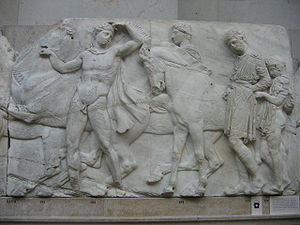
Marshal
Marshal , is a word used in several official titles of various branches of society. The word is an ancient loan word from Old French, cf...
dressing, W30, followed by several men preparing the horses W28–23 until figure W22 who, it has been suggested, may be engaged in the dokimasia, the tryout or enrollment of the knights. W24 is an ambiguous figure who might be either the protesting owner of a rejected horse or a keryx (herald) whose hand held part of an otherwise lost salpinx (trumpet), but either way this point marks the beginning of the procession proper.
The following ranks W21–1 along with N75–136 and S1–61 are all of horsemen and constitute 46% of the whole frieze. They are divided into two lines of ten ranks – the same number of the Attic tribes. All are beardless youths with the exception of two, W8 and W15, who along with S2–7 wear Thracian
Thracians
The ancient Thracians were a group of Indo-European tribes inhabiting areas including Thrace in Southeastern Europe. They spoke the Thracian language – a scarcely attested branch of the Indo-European language family...
dress of fur cap, a patterned cloak and high boots; these have been identified by Martin Robertson
Martin Robertson
Charles Martin Robertson was a British scholar of classical art and archaeology and poet. He was the elder son of Donald Struan Robertson and Petica Coursolles, née Jones , who hosted a literary salon. Martin Robertson, as he was always known, attended the Leys School and Trinity College Cambridge...
as hipparchs. Next are the four-horse chariots, each with charioteer and armed passenger, there are ten on the south frieze and eleven on the north. Since these passengers are sometimes depicted as dismounting they may be taken to represent the apobatai, participants in the ceremonial race found in Attica
Attica
Attica is a historical region of Greece, containing Athens, the current capital of Greece. The historical region is centered on the Attic peninsula, which projects into the Aegean Sea...
and Boeotia
Boeotia
Boeotia, also spelled Beotia and Bœotia , is one of the regional units of Greece. It is part of the region of Central Greece. It was also a region of ancient Greece. Its capital is Livadeia, the second largest city being Thebes.-Geography:...
.
By N42 and S89 the equestrian parade is at an end, and the following 16 figures on the north and 18 on the south are taken to be the elders of Athens judging by their braided hair, an attribute of distinguished age in Classical art. Four of these figures raise their right hand in a clenched fist gesture suggestive of a pose associated with the thallophoroi (olive branch bearers) who were older men chosen for their good looks in competition. No drill holes, however, exist for any branch to be inserted in their hands. Next in line (S107–114, N20–28) are the musicians: four kithara (a variant of the lyre
Lyre
The lyre is a stringed musical instrument known for its use in Greek classical antiquity and later. The word comes from the Greek "λύρα" and the earliest reference to the word is the Mycenaean Greek ru-ra-ta-e, meaning "lyrists", written in Linear B syllabic script...
) and four aulos (flute) players. N16–19 and S115–118 (conjectured) are the hydriaphoroi, the water-vessel carriers, here men rather than metic
Metic
In ancient Greece, the term metic referred to a resident alien, one who did not have citizen rights in his or her Greek city-state of residence....
girls mentioned in the literature on the Panathenaia. N13–15, S119–121 are the skaphephoroi, the tray bearers of the honeycombs and cakes used to entice the sacrificial animals to the altar. N1–12, S122–149 are the ten cows on the north and four cows and four sheep on the south meant for sacrifice on the acropolis
Acropolis
Acropolis means "high city" in Greek, literally city on the extremity and is usually translated into English as Citadel . For purposes of defense, early people naturally chose elevated ground to build a new settlement, frequently a hill with precipitous sides...
, presumably an abbreviated form of the hecatomb
Hecatomb
In Ancient Greece, a Hecatomb was a sacrifice to the gods of 100 cattle . Hecatombs were offered to Greek gods Apollo, Athena, and Hera, during special religious ceremonies....
usually offered on this occasion – there is an a-b-a rhythm of placid and restive cows.
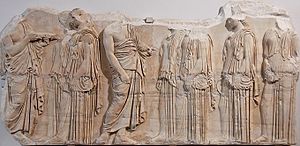
Incense
Incense is composed of aromatic biotic materials, which release fragrant smoke when burned. The term "incense" refers to the substance itself, rather than to the odor that it produces. It is used in religious ceremonies, ritual purification, aromatherapy, meditation, for creating a mood, and for...
burner), and in the case of E50–51 they have evidently just handed the marshal E49 a kanoun, making the girl the kanephoros
Kanephoros
The Kanephoros was an honorific office given to unmarried young women in ancient Greece, which involved the privilege of leading the procession to sacrifice at festivals; the highest honour was to lead the pompe at the Panathenaic Festival...
. The next groups E18–23, E43–46, are problematic. Six on the left and four on the right, if one does not count two other figures who may or may not be marshals, then this group might be taken to be the ten eponym
Eponym
An eponym is the name of a person or thing, whether real or fictitious, after which a particular place, tribe, era, discovery, or other item is named or thought to be named...
ous heroes who gave their names to the ten tribes. Their proximity to the gods indicates their importance, but selecting differently then nine of them may be the archon
Archon
Archon is a Greek word that means "ruler" or "lord", frequently used as the title of a specific public office. It is the masculine present participle of the verb stem ἀρχ-, meaning "to rule", derived from the same root as monarch, hierarchy, and anarchy.- Ancient Greece :In ancient Greece the...
s of the polis
Polis
Polis , plural poleis , literally means city in Greek. It could also mean citizenship and body of citizens. In modern historiography "polis" is normally used to indicate the ancient Greek city-states, like Classical Athens and its contemporaries, so polis is often translated as "city-state."The...
or athlothetai officials who managed the procession; there is insufficient iconographic evidence to determine which interpretation is correct. The twelve seated gods are taken to be the Olympians, they are one third taller than any other figure on the frieze and are arranged in two groups of six on diphroi
Diphros
Diphros was an Ancient Greek stool without back and with four turned legs.It was easily transportable and so in common use.Gods are shown sitting on diphroi on the Parthenon frieze; women used them in their...
(backless) stools with the exception of Zeus
Zeus
In the ancient Greek religion, Zeus was the "Father of Gods and men" who ruled the Olympians of Mount Olympus as a father ruled the family. He was the god of sky and thunder in Greek mythology. His Roman counterpart is Jupiter and his Etruscan counterpart is Tinia.Zeus was the child of Cronus...
who is enthroned. Their backs are turned to what must be the culminating event of the procession E31–35; five figures (three children and two adults, and though badly corroded the two children on the left are probably girls) the girls bear objects on their heads, while a third, probably a boy, assists an adult who may be the archon basileus, in folding a piece of cloth. This is usually understood to be the presentation of Athena
Athena
In Greek mythology, Athena, Athenê, or Athene , also referred to as Pallas Athena/Athene , is the goddess of wisdom, courage, inspiration, civilization, warfare, strength, strategy, the arts, crafts, justice, and skill. Minerva, Athena's Roman incarnation, embodies similar attributes. Athena is...
’s peplos
Peplos
A peplos is a body-lengthGreek garment worn by women before 500 BC. The peplos is a tubular cloth folded inside-out from the top about halfway down, altering what was the top of the tube to the waist and the bottom of the tube to ankle-length. The garment is then gathered about the waist and the...
, perhaps by the arrhephoroi
Arrephoros
An Arrephoros was a girl acolyte in the cult of Athena Polias on the Athenian Acropolis. They were seven to eleven years old. According to Pausanias, two Arrephoroi lived for a year on the Acropolis and concluded their term with a mystery rite called the Arrhephoria: they carried unknown objects...
.
Style
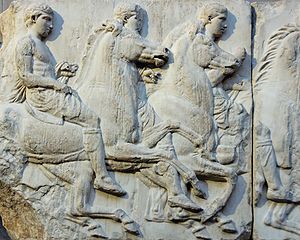
Severe style
The severe style, or Early Classic style, was the dominant idiom of Greek sculpture in the period ca. 490 to 450 BCE. It marks the breakdown of the canonical forms of archaic art and the transition to the greatly expanded vocabulary and expression of the classical moment of the late 5th century...
as witnessed on the Parthenon metopes and the evolution of the Late Classical Rich style exemplified by the Nike balustrade. What sources the designer of the frieze drew upon is hard to gauge, certainly large scale narrative art was familiar to 5th century Athenians as in the Stoa poikile
Stoa Poikile
The Stoa Poikile or Painted Porch, originally called the Porch of Peisianax , was erected during the 5th century BC and was located on the north side of the Ancient Agora of Athens. The Stoa was the location from which Zeno of Citium taught Stoicism...
painting by Polygnotos of Thasos. While there is an overall coherence to the work there are design differences on opposing sides of the frieze which has suggested to some scholars the possibility of more than one designer and a pattern of influence amongst them. There is greater nudity and frontally on the north than the south, the massing and distribution of figures is greatly different on the east than the more widely spaced west, and the east and north generally exhibit greater innovation. This evidence, along with the frequency with Greek artists were seen to collaborate, has led Jennifer Neils to hypothesize the existence of two designers working on the sculpture. This would admit the possibility of a later designer comparing and competing with the earlier and so explain the observable changes in composition.
This period is one of discovery of the expressive possibilities of the human body; there is a greater freedom in the poses and gestures, and an increased attention to anatomical verisimilitude as may be observed in the ponderated stances of the figures W9 and W4 who partially anticipate the Doryphoros
Doryphoros
The Doryphoros is one of the best known Greek sculptures of the classical era in Western Art and an early example of Greek classical contrapposto...
of Polykleitos
Polykleitos
Polykleitos ; called the Elder, was a Greek sculptor in bronze of the fifth and the early 4th century BCE...
. There is a noticeable ease to the physiques of the frieze compared with the stiffness of the metopes along with an eye for such subtleties as knuckle joints, veins and the careful articulation of musculature. One important innovation of the style is the use of drapery as an expression of motion or to suggest the body beneath; in archaic and early classical sculpture clothing fell over the body as if it were a curtain obscuring the form below, now there is the billowing chlamydes of the horsemen or the multi-pleated peploi of the women which lends a surface movement and tension to their otherwise static poses. The variation in the manes of the horses has been of particular interest to scholars attempting to discern the artistic personalities of the sculptors who laboured on the frieze, so far this Morellian
Giovanni Morelli
Giovanni Morelli was an Italian art critic and political figure. As an art historian, he developed the "Morellian" technique of scholarship, identifying the characteristic "hands" of painters through scrutiny of diagnostic minor details that revealed artists' scarcely conscious shorthand and...
analysis has been without conclusion.
Interpretation
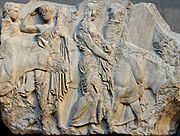
Pericles
Pericles was a prominent and influential statesman, orator, and general of Athens during the city's Golden Age—specifically, the time between the Persian and Peloponnesian wars...
”. What is now the orthodox view of the piece, however, namely that it depicts the Greater Panathenaic
Panathenaic Games
The Panathenaic Games were held every four years in Athens in Ancient Greece since 566 BC. They continued into the third century AD. These Games incorporated religious festival, ceremony , athletic competitions, and cultural events hosted within a stadium.-Religious festival:The games were part of...
procession from Eleusis
Eleusinian Mysteries
The Eleusinian Mysteries were initiation ceremonies held every year for the cult of Demeter and Persephone based at Eleusis in ancient Greece. Of all the mysteries celebrated in ancient times, these were held to be the ones of greatest importance...
to Athens, was mooted by Stuart and Revett
Nicholas Revett
Nicholas Revett was a Suffolk gentleman and amateur architect and artist.He is best known for his famous work with James Stuart documenting the ruins of ancient Athens. Its illustrations compose 5 folio volumes and include 368 etched and engraved plates, plans and maps drawn at scale...
in the second volume of their Antiquities of Athens, 1787. Subsequent interpretations have largely built on this theory even if they disallow that a temple sculpture could represent a contemporary event rather than a mythological or historical one. It has only been in recent years that an alternative thesis in which the frieze depicts the founding myth
Founding myth
A national myth is an inspiring narrative or anecdote about a nation's past. Such myths often serve as an important national symbol and affirm a set of national values. A national myth may sometimes take the form of a national epic...
of the city of Athens instead of the festival pompe has emerged.
The contention that the scene is a document of Athena’s festival is fraught with problems. Later sources indicate that a number of classes of individual who performed a role in the procession are not present in the frieze, these include: the hoplites, the allies in the Delian league
Delian League
The Delian League, founded in circa 477 BC, was an association of Greek city-states, members numbering between 150 to 173, under the leadership of Athens, whose purpose was to continue fighting the Persian Empire after the Greek victory in the Battle of Plataea at the end of the Greco–Persian Wars...
, the skiaphoroi or umbrella bearers, the female hydraiphoroi (only male hydrai bearers are portrayed) thetes, slaves, metics, the panathenaic ship and some would suggest the kanephoros, though there is evidence that she is accounted for. That what we now see was meant to be a generic image of the religious festival is problematic since no other temple sculpture depicts a contemporary event involving mortals. Locating the scene in mythical or historical time has been the principal difficulty of the line of inquiry. John Boardman
John Boardman (archaeologist)
Professor Sir John Boardman FBA is a classical art historian and archaeologist, "Britain's most distinguished historian of ancient Greek art." -Biography:...
has suggested that the cavalry portray the heroization of the marathonomachoi, the hoplites who fell at Marathon
Battle of Marathon
The Battle of Marathon took place in 490 BC, during the first Persian invasion of Greece. It was fought between the citizens of Athens, aided by Plataea, and a Persian force commanded by Datis and Artaphernes. It was the culmination of the first attempt by Persia, under King Darius I, to subjugate...
in 490, and that therefore these riders were the Athenians who took part in the last pre-war Greater Panathenaia. In support, he points out, the number of horsemen, chariot passengers (but not charioteers), grooms and marshals comes to the same as the number Herodotos gives for the Athenian dead: 192. Equally suggestive of a reference to the Persian War is the similarity several scholars have noted of the frieze to the Apadana
Apadana
The Apadāna is a collection of biographical stories found in the Khuddaka Nikaya of the Pāli Canon, the scriptures of Theravada Buddhism. It is thought by most scholars to be a late addition to the canon, composed during the 1st and 2nd century BCE...
sculpture in Persepolis
Persepolis
Perspolis was the ceremonial capital of the Achaemenid Empire . Persepolis is situated northeast of the modern city of Shiraz in the Fars Province of modern Iran. In contemporary Persian, the site is known as Takht-e Jamshid...
. This has variously been posited to be democratic Athens counter posing itself to oriental tyranny or aristocratic Athens emulating the Imperial East. Further to this zeitgeist argument there is J.J. Politt’s contention that the frieze embodies a Periclean manifesto, which favours the cultural institutions of agones (or contests, as witnessed by the apobatai), sacrifices and military training as well as a number of other democratic virtues. More recent scholarship pursuing this vein has made the frieze a site of ideological tension between the elite and the demos with perhaps only the aristocracy present and merely veiled reference to the ten tribes.

Athena Parthenos
Athena Parthenos was the title of a massive chryselephantine sculpture of the Greek goddess Athena made by Phidias and housed in the Parthenon in Athens. Its epithet was an essential character of the goddess herself...
all illustrate the mythological past and as the gods are observing on the east frieze it is natural to reach for a mythological explanation. Chrysoula Kardara, has ventured that the relief shows us the first Panathenaic procession instituted under the mythical King Kekrops. This explanation would account for the absence of the allies and the ship as these post-date the original practice of the sacrificial rite. In evidence she offers E35 as the future King Erichthonios
Erichthonius of Athens
King Erichthonius was a mythological early ruler of ancient Athens, Greece. He was, according to some legends, autochthonous and raised by the goddess Athena. Early Greek texts do not distinguish between him and Erectheus, his grandson, but by the fourth century B.C...
presenting the first peplos to his predecessor Kekrops, iconographically similar to the boy’s depiction on a fragmentary kylix of the 450s. A recent interpretation by Joan Breton Connelly
Joan Breton Connelly
Joan Breton Connelly is an American classical archaeologist and Professor of Classics and Art History at New York University. She is Director of the Yeronisos Island Excavations and Field School in Cyprus. Connelly was awarded a MacArthur Fellowship in 1996...
identifies the central scene on the east frieze (hence above the door to the cella and focal point of the procession) not as the handing over of Athena’s peplos by the arrhephoroi but the donning of sacrificial garb by the daughter of King Erechtheus
Erechtheus
Erechtheus in Greek mythology was the name of an archaic king of Athens, the re-founder of the polis and a double at Athens for Poseidon, as "Poseidon Erechtheus"...
in preparation for the sacrifice of her life. An interpretation suggested by the text of the fragmentary papyrus remains of Euripides
Euripides
Euripides was one of the three great tragedians of classical Athens, the other two being Aeschylus and Sophocles. Some ancient scholars attributed ninety-five plays to him but according to the Suda it was ninety-two at most...
’s Erichtheus wherein her life is demanded in order to save the city from Eumolpos and the Eleusinians. Thus, the gods turn their backs to her to prevent the pollution from the sight of her death. A contentious subject in the field, Connelly's solution to the problem of meaning poses as many problems as it answers.
Influence
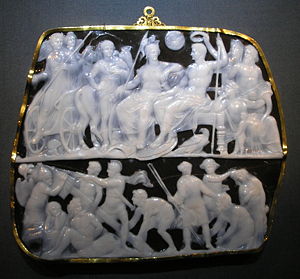
Pottery of Ancient Greece
As the result of its relative durability, pottery is a large part of the archaeological record of Ancient Greece, and because there is so much of it it has exerted a disproportionately large influence on our understanding of Greek society...
and grave stelae
Stele
A stele , also stela , is a stone or wooden slab, generally taller than it is wide, erected for funerals or commemorative purposes, most usually decorated with the names and titles of the deceased or living — inscribed, carved in relief , or painted onto the slab...
where we can find some echo not just of motifs, themes, poses but tenor, as well. Direct imitation, and indeed quotation, of the frieze begins to be pronounced around 430 BC. One example, an explicit copy, is a pelike
Pelike
A pelike is a one-piece ceramic container similar to an amphora.It has two open handles that are vertical on their lateral aspects and even at the side with the edge of the belly, a narrow neck, a flanged mouth, and a sagging, almost spherical belly....
attributed to the Wedding Painter of a youth “parking up” a horse exactly in the manner of the figure W25 on the frieze. While those vase paintings that resemble the frieze cluster around 430, the vases that quote the pediments are datable nearer to the end of the century, giving further evidence of the priority of the sculptural program. More accomplished painters also found inspiration in the sculpture, namely Polygnotos I
Polygnotos (vase painter)
Polygnotos , a Greek vase-painter in Athens, is considered one of the most important vase painters of the red figure style of the high-classical period...
and his group, especially the Peleus Painter, the Kleophon Painter
Kleophon Painter
The Kleophon Painter is the name given to an anonymous Athenian vase painter in the red figure style who flourished in the mid-to-late 5th century BCE...
and the late work of the Achilles Painter
Achilles Painter
The Achilles Painter, was a vase-painter active ca. 470-420 BC. His name vase is an amphora in the Vatican museums depicting Achilles. Sir John Beazley attributed over 200 vases to his hand, the largest share being red-figure and white-ground lekythoi. In his middle phase , he decorates more open...
. Later painters of talent also managed to capture the mood of eusebeia or thoughtful piety of the procession as, for example, on the volute krater of the Kleophon Painter
Kleophon Painter
The Kleophon Painter is the name given to an anonymous Athenian vase painter in the red figure style who flourished in the mid-to-late 5th century BCE...
of a sacrifice to Apollo, which shares the quiet dignity of the best of High Classical sculpture.
The impact of the frieze can be sought in the Attic relief sculpture of the late 5th century; this resonance may be discovered to some degree in the public works of the Hephaisteion frieze and the Nike Athena balustrade, where the imagery of the seated gods and the sandal-binder respectively likely owes a debt to the Parthenon. There are also traces found on the private commissions of grave stelae from the period, for example the “cat stele” from Aegina bears a distinct similarity to the figures N135–6. As does the Hermes of the four-figure relief known from a Roman copy. Later classicizing art of the Hellenistic and Roman eras also looked to the frieze for inspiration as attested by the Lycian Sarcophagus of Sidon, Phoenicia, the Ara Pacis Augustae, the Gemma Augustea
Gemma Augustea
The Gemma Augustea is a low-relief cameo engraved gem cut from a double-layered Arabian onyx stone. It is commonly agreed that the gem cutter who created the Gemma Augustea was either Dioscurides or one of his disciples, in the second or third decade of the 1st century AD.- Creation and...
, and many pieces of the Hadrian
Hadrian
Hadrian , was Roman Emperor from 117 to 138. He is best known for building Hadrian's Wall, which marked the northern limit of Roman Britain. In Rome, he re-built the Pantheon and constructed the Temple of Venus and Roma. In addition to being emperor, Hadrian was a humanist and was philhellene in...
ic generation.
See also
- ParthenonParthenonThe Parthenon is a temple on the Athenian Acropolis, Greece, dedicated to the Greek goddess Athena, whom the people of Athens considered their virgin patron. Its construction began in 447 BC when the Athenian Empire was at the height of its power. It was completed in 438 BC, although...
- Acropolis of AthensAcropolis of AthensThe Acropolis of Athens or Citadel of Athens is the best known acropolis in the world. Although there are many other acropoleis in Greece, the significance of the Acropolis of Athens is such that it is commonly known as The Acropolis without qualification...
- Age of PericlesAge of PericlesFifth-century Athens refers to the Greek city-state of Athens in the period of roughly 480 BC-404 BC. This was a period of Athenian political hegemony, economic growth and cultural flourishing formerly known as the Golden Age of Athens or The Age of Pericles. The period began in 480 BC when an...
- Panathenaic Festival
Sources
- Ashmole, B. (1972) Architect and Sculptor in Classical Greece.
- Boardman, J. (1985). The Parthenon and its Sculptures, University of Texas Press. ISBN 0292764987
- Boardman, J. (1999) The Parthenon Frieze: a closer look, Revue Archeologique, 99:2, p. 305–330.
- Boedeker, D. (2003) Democracy, Empire and the Arts in Fifth-century Athens.
- Bowie, T., Thimme, D. (1971) The Carrey Drawings of the Parthenon Sculptures.
- Brommer, F. (1977). Der Parthenonfries.
- Bugh, G. (1988) The Horsemen of Athens.
- Connelly, J.B. (1993) Parthenon and Parthenoi: A Mythological Interpretation of the Parthenon Frieze, AJAAmerican Journal of ArchaeologyThe American Journal of Archaeology , the peer-reviewed journal of the Archaeological Institute of America, has been published since 1897...
100, 58–80 - Cook, R.M. (1976) Greek Art, Its Character and Influence.
- Cyriac of Ancona, Later Travels, ed. Clive. Foss, Edward Williams Bodnar, I Tatti Renaissance Library, 2003.
- Donohue, A. A., (ed). (2005) Periklean Athens and Its Legacy: Problems and Perspectives.
- Höckmann, U., Krug, A. (eds), (1977) Festschrift für Frank Brommer.
- Hurwit, J.M. (ed) (2005) Periklean Athens and Its Legacy: Problems and Perspectives.
- Jenkins, I. (2002). The Parthenon Frieze, British Museum Press. ISBN 0714122378
- Kardara, C. (1964) Γλαυχκώπις, ο Aρχαϊκός Nαός και το Θέμα της Zωφόρου του Παρθενώνα', Archaiologike Ephemeris, 62–158.
- Kyle, D.G. (1993) Athletics in Ancient Athens.
- Lawrence, A.W. (1951) The Acropolis and Persepolis, JHSJournal of Hellenic StudiesThe Journal of Hellenic Studies is a peer-reviewed academic journal which contains articles that pertain to Hellenic studies, i.e. the language, literature, history, and archaeology of the ancient Greek world, and reviews of recent books of importance to Hellenic studies. It is published annually...
, 1951, p. 116–19 - Lycurgus Against Leocrates
- Michaelis, A (1871) Der Parthenon
- Neils, J. (2001). The Parthenon Frieze, Cambridge University Press. ISBN 0521641616
- Neils, J. (ed.) (1993). Goddess and Polis: The Panathenaic Festival in Athens, Princeton University Press. ISBN 0691036128
- Neils, J. (ed) (1996) Worshipping Athena.
- Pollitt, J.J. (1972) Art and Experience in Classical Greece.
- Ridgway, B. (1981) Fifth Century Styles in Greek Sculpture.
- Robertson, M. (1992) The Art of Vase Painting in Classical Athens.
- Robertson, M. and A. Frantz. (1975). The Parthenon Frieze, Oxford University Press.
- Roccos, L.J. The Kanephoros and her Festival Mantle in Greek Art, AJA 99, p. 641–66.
- Root, M.C. The Parthenon Frieze and the Apadana Reliefs: Reassessing a Programatic Relationship, AJA:89, p. 103–20.
- Schuchhardt, W.H. (1930) Die Entstehung des Parthenonfries, Jahrbuch des Deutschen Archäologischen Instituts 45, p. 218–80.
- Stuart, Revett, The Antiquities of Athens: And Other Monuments of Greece, Elibron Classics edition, 2002
- Ross Holloway, R. (1966) The Archaic Acropolis and the Parthenon Frieze , The Art Bulletin, Vol. 48, No. 2, p. 223–226
- Wesenberg, B. (1995) Panathenaische Peplosdedikation und Arrhephorie. Zur Thematik des Parthenonfrieses JdI 110, p. 149–78.

